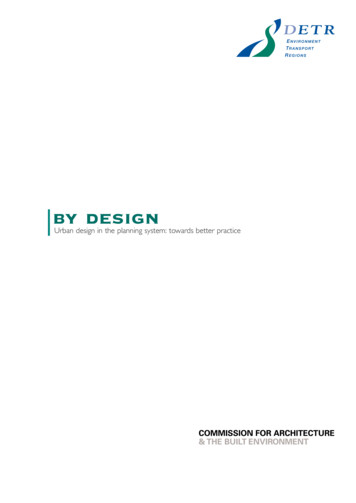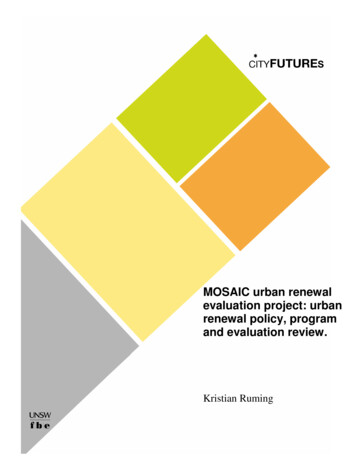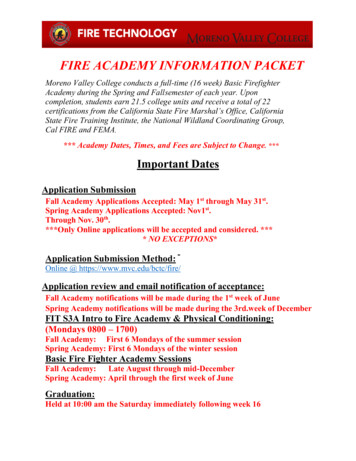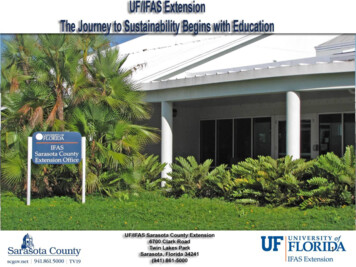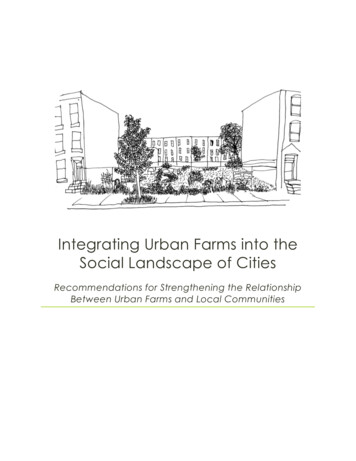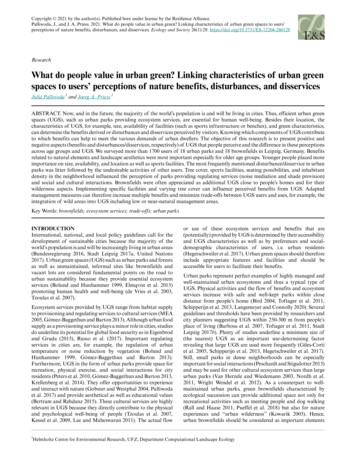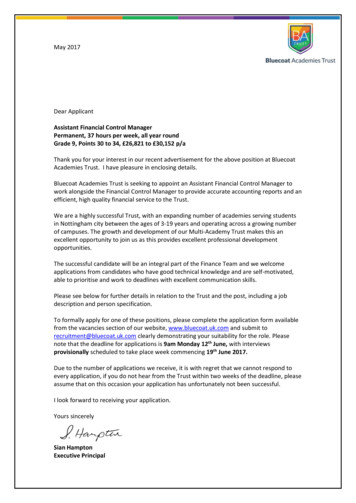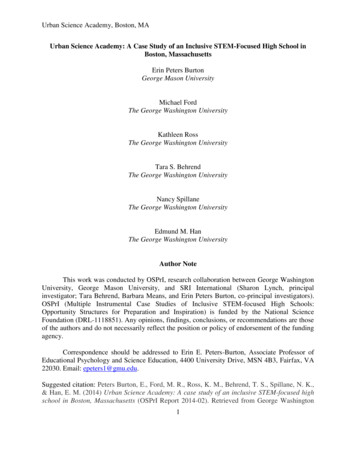
Transcription
Urban Science Academy, Boston, MAUrban Science Academy: A Case Study of an Inclusive STEM-Focused High School inBoston, MassachusettsErin Peters BurtonGeorge Mason UniversityMichael FordThe George Washington UniversityKathleen RossThe George Washington UniversityTara S. BehrendThe George Washington UniversityNancy SpillaneThe George Washington UniversityEdmund M. HanThe George Washington UniversityAuthor NoteThis work was conducted by OSPrI, research collaboration between George WashingtonUniversity, George Mason University, and SRI International (Sharon Lynch, principalinvestigator; Tara Behrend, Barbara Means, and Erin Peters Burton, co-principal investigators).OSPrI (Multiple Instrumental Case Studies of Inclusive STEM-focused High Schools:Opportunity Structures for Preparation and Inspiration) is funded by the National ScienceFoundation (DRL-1118851). Any opinions, findings, conclusions, or recommendations are thoseof the authors and do not necessarily reflect the position or policy of endorsement of the fundingagency.Correspondence should be addressed to Erin E. Peters-Burton, Associate Professor ofEducational Psychology and Science Education, 4400 University Drive, MSN 4B3, Fairfax, VA22030. Email: epeters1@gmu.edu.Suggested citation: Peters Burton, E., Ford, M. R., Ross, K. M., Behrend, T. S., Spillane, N. K.,& Han, E. M. (2014) Urban Science Academy: A case study of an inclusive STEM-focused highschool in Boston, Massachusetts (OSPrI Report 2014-02). Retrieved from George Washington1
Urban Science Academy, Boston, MAUniversity, Opportunity Structures for Preparation and Inspiration in STEM .research.gwu.edu/files/downloads/OSPrI Report 2014-02.pdf2
Urban Science Academy, Boston, MATable of Contents1.0EXECUTIVE SUMMARY . 42.0 INTRODUCTION . 52.1.FRAMING THE STUDY . 52.2. SELECTION OF URBAN SCIENCE ACADEMY . 72.3. DATA COLLECTION . 73.0 CONTEXT . 93.1. BOSTON PUBLIC SCHOOLS . 93.2. LOCATION . 113.3. HISTORY. 123.4. ADMISSIONS AND DEMOGRAPHICS . 134.0 EXPLORING THE DESIGN AND IMPLEMENTATION DIMENSIONS . 144.1. STEM-FOCUSED CURRICULUM (CC1) . 144.2. INSTRUCTIONAL STRATEGIES (CC2) . 204.3. USE OF TECHNOLOGY (CC3) . 304.4. FORMAL/INFORMAL LEARNING (CC4) . 344.5. PARTNERSHIPS (CC5) . 384.6. EARLY COLLEGE-LEVEL COURSEWORK (CC6) . 434.7. WELL-PREPARED TEACHING STAFF (CC7). 474.8. INCLUSIVE STEM-FOCUSED MISSION (CC8) . 564.9. ADMINISTRATIVE STRUCTURE (CC9) . 594.10. SUPPORTS FOR STUDENTS UNDER-REPRESENTED IN STEM FIELDS (CC10) .614.11. EMERGENT THEMES . 694.11.1.School Culture . 694.11.2.Data Driven Decision Making. 735.0EXPLORING THE OUTCOMES DIMENSION . 746.0DISCUSSION AND IMPLICATIONS . 957.0 REFERENCES . 973
Urban Science Academy, Boston, MA1.0EXECUTIVE SUMMARYThis case study of Urban Science Academy (USA) is the fifth in a set of eight school-level caseson inclusive STEM-focused high schools (ISHSs). In contrast to highly selective STEM-focusedschools that target students already identified as being STEM gifted/talented, the goal of ISHSsis to develop new sources of STEM talent among a wide range of students underrepresented inSTEM fields, and provide them with the means to succeed in school and in STEM collegemajors, jobs and careers. USA is one such ISHS located in Boston, Massachusetts. The schoolwas founded in 2005 when Boston Public Schools received a multi-million dollar grant from theBill and Melinda Gates Foundation to create smaller high schools where students could receivemore individualized attention to help them achieve.This case study provides an in-depth look at USA’s design, implementation, and outcomes,examining the school using a framework of 10 candidate critical components pulled from theresearch literature. A team of six researchers visited the school in March 2013 and systematicallycollected data from classroom observations, interviews, and focus groups, as well as examiningpublic information documents and outcome records. This examination of USA revealed valuableinsights into a successful ISHS; the school provided a unique approach to organizing thecurriculum to move students to increased rigor, accepting students who may not have had anoutstanding academic record, and supporting the students through innovative partnerships withbusiness, industry, and nearby colleges. The faculty and administration had high expectations forthe students and were aware of the supports that were needed to help their students succeed. Thisenvironment fostered a community of students and teachers who were open to creatingopportunity structures for students and taking advantage of them.Analyses showed that some of the 10 candidate critical components were more salient thanothers at USA. Of the 10 components examined in this study, many were prominently featured atUSA; however our findings suggest that the Supports for Underrepresented Students andInclusive STEM Mission played dominant roles in characterizing the school. The school’s WellPrepared Teaching Staff, Administrative Structure, Early College Level Coursework, along withits STEM Focused Curriculum were also important to the school’s program. USA also includedevidence of Blended Formal/Informal Learning Beyond the Typical School Day, Week or Year;Reform Instructional Strategies and Project Based Learning; Integrated Innovative TechnologyUse; and, Real-World STEM Partnerships .Additionally, themes that emerged from the data that were not covered within the 10 candidatecritical components included the use of Data-driven Decisions that USA stakeholders made thatwere instrumental in the relevance of supports offered to students. Furthermore, the developmentof a caring School Culture was another emergent theme identified where the entire schoolcommunity expected students to be high performing and take risks. All students at USA weresupported by a core group of teachers, administrators, and larger community who workedbeyond expectations to support their academic and personal growth.4
Urban Science Academy, Boston, MA2.0INTRODUCTIONThe inclusive STEM-focused high school (ISHS) is a new type of school gaining momentumacross the United States. ISHSs focus on increasing literacy in science, technology, engineering,and mathematics through innovative approaches to providing opportunities for academicallyaverage students, including students entering high school below grade level, to master rigorouscollege preparatory STEM coursework. Thus, they create pathways for students from groupsunder-represented in college STEM majors and careers. In 2010, President Obama issued achallenge to create more than 1,000 new STEM-focused schools over the next decade (Obama,2010) based on recommendations of the President’s Council of Advisors on Science andTechnology in their report, Prepare and Inspire: K-12 Education in STEM for America’s Future(PCAST, 2010). As early ISHSs have demonstrated success in engaging and broadeningparticipation of underrepresented groups in college preparatory STEM coursework, new ones arecropping up all over the country. However, there has been no significant characterization ordefinition of this type of school to date. Under a grant from the National Science Foundation(NSF), this study: Multiple Instrumental Case Studies: Opportunity Structures for Preparationand Inspiration (OSPrI), seeks to characterize and identify the structures of successful ISHSs byexamining their design, implementation, and outcomes within the context of their community.This case, Urban Science Academy (USA), represents the fifth in a set of cases describing thecharacteristics of successful ISHSs diverse in terms of geographic location, studentdemographics, and context. USA is unique to our first set of eight case studies in that it is ascience-themed high school in a large urban public school district in the Northeast. Its context isalso unique because the school district has tiers of high schools with different levels of academicachievement required for admission. USA, as an ISHS positioned in the lower tier open tostudents regardless of prior academic achievement, expands opportunities for students who mightnot otherwise be challenged and supported in attaining STEM literacy and college preparedness.2.1.FRAMING THE STUDYThis case study of Urban Science Academy asks:1. Is there evidence of each of the candidate critical components (shown in Table 1) in thedesign of USA, the school that is the focus of the case study?2. How are the critical components implemented at USA? Do other components emergefrom the data collected on-site that are critical to the school’s character and success?3. What are the contextual affordances and constraints that influence USA’s design,implementation and student outcomes?4. How do USA’s student STEM outcomes compare with those of the school district andstate (e.g., STEM achievement measures, graduation rates, college acceptance rates)?Our research approach is to explore three dimensions of an ISHS--design, implementation, andstudent outcomes--focusing on the ten candidate critical components defined in Table 1.Additionally, the study was designed to capture themes that emerged from the data. Note that the5
Urban Science Academy, Boston, MAorder of the candidate critical components in Table 1 is not intended to indicate relativeimportance. Each case study reports on the prominence of particular components based on thefindings.Table 1Definitions of Candidate Critical Components11. STEM-Focused Curriculum. Strong courses in all 4 STEM areas, or, engineering and technology explicitly,intentionally integrated into STEM subjects and non-STEM subjects.2. Reform Instructional Strategies and Project-Based Learning. STEM classes emphasizing active, immersive,and authentic instructional practices/strategies informed by research; opportunities for project-based learning andstudent production; performance-based assessment practices that have an authentic fit with STEM disciplines.3. Integrated, Innovative Technology Use. Technology used to connect students with information systems,models, databases, STEM research resources, teachers, mentors, social networking resources for STEM ideas;includes during and outside the school day.4. Blended Formal/Informal Learning beyond the Typical School Day, Week, or Year. Learning opportunitiesnot bounded but ubiquitous; learning spills into areas regarded as informal STEM education, includingapprenticeships, mentoring, social networking, and doing STEM in locations off of the school site, e.g., in thecommunity, museums and STEM centers, and business and industry.5. Real-World STEM Partnerships. Students connecting to business/ industry/world of work via mentorships,internships, or projects that occur within or outside the normal school day/year.6. Early College-Level Coursework. Opportunities for students to take college level course work and earncollege credits, e.g., AP classes, online college courses, college classes at institutions of higher education;facilitated by flexible school schedule.7. Well-Prepared STEM Teaching Staff. Teachers certified to teach in their STEM subject areas and havingadvanced STEM content knowledge and/or practical experience in STEM careers; opportunities for professionaldevelopment.8. Inclusive STEM Mission. Stated mission/goals to prepare students for STEM, with emphasis on recruitingstudents from underrepresented groups.9. Administrative Structure. Various structures (e.g., school-within-a-school, charter school, magnet school),affected by the school’s age and provenance, i.e., whether the school was converted from another model or wascreated “from scratch” as a STEM school; various funding structures.10. Supports for Underrepresented Students. Bridge programs, tutoring programs, extended school day,extended school year, or looping to strengthen student transitions to STEM-focused curriculum; altered, improvedopportunity structures, i.e., students positioned for STEM college majors, careers, and jobs.This case study includes a brief summary of school selection and data collection methods. Thereader is referred to the Research Framework document located on the OSPrI project website1Herein after referred to simply as critical components, with the understanding that they are theorized to be criticalto the success of an ISHS.6
Urban Science Academy, Boston, MA(ospri.research.gwu.edu) for details on the rationale for examining the ten critical components,and methods for school selection and recruitment, data collection, and data analysis.2.2.SELECTION OF URBAN SCIENCE ACADEMYThe goal of the OSPrI study is to characterize a set of exemplar inclusive STEM-focused highschools and conduct a cross-case analysis to develop a theory of action for scaling up suchschools. By exemplar, we mean that the school has demonstrated successful student outcomes(e.g., graduation rates, college acceptance rates, science and mathematics achievement scores),including some unusual successes with its unique student population in comparison to schooldistrict or state averages, given the demographically appropriate comparison groups. We defineinclusive in terms of the school’s admission criteria and process. An inclusive school is designedfor a range of students, not just gifted and talented. A school that is inclusive may use a lotterysystem if more students apply to the school than there are spaces. While it may have goals for astudent body that is demographically diverse, it does not have overly restrictive academicadmissions criteria that would exclude students from a challenging college preparatory academicprogram because of prior academic achievement. Such inclusive schools typically have at least50% or more of their students from groups underrepresented in STEM fields (e.g., AfricanAmericans, Hispanics, low income students, and those who would be the first in their family toattend college). By STEM-focused, we mean that the school requires more rigorous mathematicsand science courses to graduate than district and state requirements; or that its science,technology, engineering and mathematics classes are more integrated than traditional schools.We were primarily interested in STEM-focused high schools that required all their students tocomplete college preparatory courses including at least four years of mathematics; and four yearsof science. The school may or may not also require engineering or technology courses.Urban Science Academy was selected as the fifth ISHS for our research study seeking to definethe phenomena of inclusive STEM-focused high schools. Each school was chosen as a criticalcase (Yin, 2009), with a unique governing structure and academic organization likely to havebroad effects on implementation and outcomes. Urban Science Academy was included afterbeing recommended by a member of the Council of State Science Supervisors (CSSS). Afterreviewing publically available data on the school, we found that the school matched our selectioncriteria for outcomes, inclusiveness, and STEM-focus, as will be described in this case study. Weapproached the school administration with the intended purpose of our study and our researchrequest was approved.2.3.DATA COLLECTIONData collection began before the site visit to the school, by using publicly available data anddocuments found on the school and district websites, to begin to understand the school’s designand context, and to collect demographic and outcome data. Also, two online questionnaires werecompleted prior to the visit: a school description questionnaire completed by a schooladministrator, and a survey completed by the school’s teachers. Phone interviews wereconducted with the administrator to follow up on questionnaire responses. To understandimplementation, the OSPrI study team visited the school and collected design and7
Urban Science Academy, Boston, MAimplementation data using observation instruments and focus group and interview protocols. Thedata collection activities during the site visit are shown in Table 2.Table 2.Data Collection Activities during USA Site VisitClassroom ObservationsSTEM ClassesAlgebra 1AP CalculusAP ChemistryAP yTechnology ClassFocus GroupsTeachers/AdministrationTeachers of ScienceTeachers of MathematicsInstructional Teacher LeadersTeachers on Use of TechnologySchool Leadership TeamParentsInterviewsSchool PersonnelGuidance CounselorAssistant HeadmasterFamily/Community Engagement SpecialistResource TeacherNon-STEM Classes10th Grade Humanities12th Grade HumanitiesStudents11th/12th AP STEM students9th Grade StudentsStudent Leadership TeamNon-School PersonnelBrigham & Women’s HospitalJFY NetWorks Program DirectorPEER Health ExchangeBoston CollegeBound ProgramCloud FoundationTechnology Goes HomeOther ActivitiesSchool TourResearcher ActivitiesTeam Debrief – Day 1Team Debrief – Day 2This case study is organized to inform the reader about the context underlying the case, thenpresents findings in two sections, one exploring the design and implementation dimensions, andthe other, the outcomes dimension.8
Urban Science Academy, Boston, MA3.0CONTEXTThis case describes Urban Science Academy, an ISHS and urban public school in Boston,Massachusetts. This context section positions USA within the public school system and Bostoncommunity, and describes its founding and evolution up to the time of this case study.3.1.BOSTON PUBLIC SCHOOLSUSA is part of Boston Public Schools (BPS), an urban school system that is the oldest schoolsystem in the United States, founded in 1647. The demographics of students in this schoolsystem are described later in the Context section where it is compared to USA’s studentdemographics.3.1.1. Types of SchoolsBPS operates several types of high schools: exam, pilot, innovation, in-district charter, andtraditional comprehensive public high schools (Table 3). A student entering high school throughthe BPS system may apply to any of the several types of high schools, with the exception that,for a student to attend an exam and some pilot schools, the student will need to meet certainselection requirements, as described in the section that follows.Table 3.Boston Public School High School OrganizationAnother Course to College Boston Adult Tech. AcademyBoston Arts Academy Boston Community LeadershipAcad. Boston Day & Evening Academy Boston Green Academy Boston International HSBoston Latin Academy ⱵBoston Latin School ⱵBrighton HighBurke HighCharlestown HighComm. Acad. Sci. HealthCommunity AcademyDearborn (6-12)Dorchester AcademyEast Boston HighEnglish HighExcel HighFenway High Greater Egleston High Harbor High SchoolKennedy Acad. for Health Careers Lyon 9-12 Margarita Muñiz Academy *McKinley Prep High SchoolMcKinley South End AcademyNew Mission High Newcomers AcademyO’Bryant Math & Science ⱵQuincy Upper (6-12) (IB) Snowden International (IB)TechBoston Academy (6-12) Urban Science AcademyWest Roxbury AcademyKeyⱵ Exam School (3 schools) Pilot School (9 Schools) In-district Charter School (2schools)* Innovation School (1 school)Boston Public School Organization 2013-2014. Retrieved from www.bostonpublicschoolsThe exam schools in Boston are the most selective. Admission is based entirely on twodocuments, a student’s transcript and scores on the Independent School Entrance Exam (ISEE).When reviewing a student’s transcript, only the mathematics and English grades from a student’sseventh grade year and the first two marking periods of their eighth grade year are reviewedwhen a student is considered for admission (BPS Website). In order to be offered admission,students must have a competitive GPA on their middle school transcripts and a high score on the9
Urban Science Academy, Boston, MAISEE. Of the 35 total public high schools in Boston, 3 are exam schools, and 21 are pilot schools,described next.The pilot schools are part of the Boston Public School district but have autonomy over budget,staffing, governance, curriculum/assessment, and the school calendar, to provide increasedflexibility. Boston Public Schools cites that these schools were explicitly created to be models ofeducational innovation and to serve as research and development sites for effective urban publicschools (www.bostonpublicschools.org). While originally created to be laboratories ofinnovation for urban schools, pilot schools in Boston have been criticized as serving a less thanrepresentative sampling of students due to additional admission application requirements. Most ifnot all of the pilot schools require students to submit transcripts, teacher recommendations,personal essays, or even audition to be considered for admission (Center for CollaborativeEducation, 2007). While pilot schools do not have minimum GPA or test requirements, theseadditional application requirements have led to some criticism that pilot schools may actually beenrolling higher performing students than those that go to traditional schools in Boston.Depending on the pilot school, it may be using the same lottery system as the comprehensivehigh schools or it may have a separate selection process involving evaluation of applicant essays,teacher recommendations, transcripts, or auditions (Center for Collaborative Education, 2007).Like the BPS pilot schools, Margarita Muñiz Academy, the one innovation school shown inTable 3 was given greater autonomy and flexibility in its budget, schedule, calendar, staffingpolicies and professional development. Unlike the pilot schools, it did not have the uniform setof exemptions to the teachers' contract. Rather, as an innovation school, its governing board hasto negotiate waivers to facilitate the specific school plans.In-district charter high schools, like Boston Day and Evening Academy, Boston Green Academy,and Kennedy Academy for Health Careers are schools whose applications must first be approvedby a host school district and, with a few exceptions, the local teachers union. Teachers in indistrict charter schools must belong to the local union, but they may be subject to a thin contractthat waives most of the provisions not associated with compensation. In-district charter schoolsare authorized by the state Board of Elementary and Secondary Education and receive theirfunding through the state, but the amount they can keep and use at their discretion is usually asubject for negotiation with their sponsoring district.Lastly, there are the traditional public high schools in Boston; USA is in this category. Theseschools are open to all students and a lottery system is used to place students if more studentsapply to a school than there are spots available. These schools are subject to the governance ofBoston Public Schools, and rely on the district for curriculum and assessment support as well asstaffing. Like the innovation school, these traditional high schools are subject to union rules andlaws but would be required to negotiate a waiver to facilitate any changes in work conditionsstipulated in the contract. Some of these schools have a theme that may attract particularstudents, such as the science theme at Urban Science Academy.3.1.2. Boston Public School Teacher Union10
Urban Science Academy, Boston, MAThe Boston Teachers Union has major influence in the operation of BPS. The union represents5,500 teachers and other school professionals including nurses, psychologists, and guidancecounselors, and is affiliated with the American Federation of Teachers, as described on the BPSwebsite. Since the primary responsibilities of the union are to represent their members innegotiating and enforcing the contract, this positions the organization as a major influence insetting the culture and day-to-day school operations. The union enforces strict guidelines andacts as a constant reinforcement of the duties of both teacher and administration. Theenforcement has created distinct hierarchical roles within the school, and the faculty andadministration at USA have worked to progress the educational offerings despite the challenge ofthis inflexible system. The findings on administrative structure describe how USA has managedthis challenge.3.2.LOCATIONAs shown in Figure 1, UrbanScience Academy is located inWestRoxbury,aneighborhood within Boston.This neighborhood can becharacterized as a suburbwithin the city, as the streetsare lined with large singlefamily homes.Figure 1Location of Urban ScienceAcademy, a Boston public highschool in West Roxbury, MA.Urban Science Academy islocated in a far southwestquadrant of Boston. Studentsand Staff both commented onthe difficultly of reaching thisschoolviapublictransportation, so the schooltransports students from themajor subway stops to andfrom the school.Urban Science AcademyThe school, shown in Figure 2, is located near the 19th Century site of Brook Farm in thewatershed of the upper Charles River, situated between Millennium Park and a large wetland.11
Urban Science Academy, Boston, MAWithin the wetland, there is an island accessible by a boardwalk from the shore behind theschool where the Boston Schoolyard Initiative built an outdoor classroom and science educationsite in collaboration with the Urban Science Academy.Figure 2View of Urban Science Academy, West Roxbury, MA, from wetland.Urban Science Academy islocated near a wetland in theWest Roxbury neighborhood ofBoston, MA. This buildingoriginally housed four separateschools; at the time of our visit ithoused only Urban ScienceAcademy (right side) and WestRoxbury Academy (left side).3.3.HISTORYUSA opened in 2005 when Boston Public Schools received a multi-million dollar grant from theBill and Melinda Gates Foundation to address low student performance across the district. Thestrategy was to create smaller high schools where students could receive more individualizedattention to help them achieve. With this money, BPS closed four large comprehensive highschools in the district and reopened facilities to house new smaller theme-based schools. As aresult, the former high school site known as West Roxbury High School reopened as foursmaller, themed schools: Media Communications Technology High School, Brook FarmBusiness & Service Career Academy, Parkway Academy of Technology and Health, and UrbanScience Academy. USA chose an ecology/science theme to capitalize on the nearby naturalresources and relative proximity to Boston College and the Urban Ecology Institute.USA was initially a small school, serving a student body of approximately 300 students. Fromthe time the school first opened in 2005 until 2011, USA established itself as a “School on theMove Finalist”, a highly selective competition held by EdVestors where only 5-10% of BPS areeligible to apply. The prize recognized rapidly improving schools that made exemplary progressin advancing the academic achievement of all students. Unfortunately not all the new smallerhigh schools in the district were able to boast the same level of improvement, and with theending of the Gates funding, well-performing schools such as USA were asked to absorb lower12
Urban Science Academy, Boston, MAperforming schools. So in the fall of 2011, three of the four schools inside the West RoxburyEducation Complex were closed. Brook Farm Academy and Media CommunicationsTechnology High School were merged into one school now called West Roxbury Academy.Urban Science Academy, while keeping the same name and leadership, absorbed the teachersand students of Parkway Academy of Technology and Health. USA’s student body almostdoubled to 576 students growing to a medium-sized high school, rather than a small high school.Since the merger, USA faced challenges due to the increased number of students, including thosewho had been in the technology and health-themed school, and the blending of teachers
apprenticeships, mentoring, social networking, and doing STEM in locations off of the school site, e.g., in the community, museums and STEM centers, and business and industry. 5. Real-World STEM Partnerships. Students connecting to business/ industry/world of work via mentorships,

